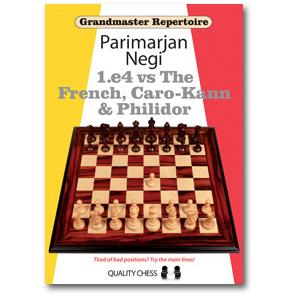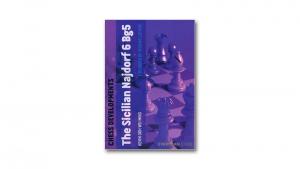
Book review: 1.e4 vs The French, Caro-Kann & Philidor by GM Parimarjan Negi
I’m a hard man to please, and no more so than when it comes to chess books. I expect honesty, I expect diligence, I expect innovation, and, perhaps most difficult of all, I expect my short attention span to be entertained at all times. It’s a tough sell, I grant you.
But every now and then, every once-in-a-FIDE-cycle, a book comes along that seriously impresses me. And recently, I received another of these rare, pleasant shocks. Indian GM Parimarjan Negi’s first book of his 1.e4 repertoire series is a real stand-out, an excellent piece of chess authorship. And it even kept me engaged!
The first book of his series sees Negi take on the French, the Caro-Kann and the Philidor Defence – all in one book! Furthermore, Negi has chosen (or been politely encouraged by his editors, I’d wager) to focus on the absolute main lines against each defence. Given all of this, it’s quite amazing that he’s managed to fit it all in to one book (albeit one of 600 pages). Surely he’s made some sacrifices, I hear you ponder – surely some short-cuts here and there; surely some important omissions? “No!” I answer with resounding and unexpectedly strong support of our author, “Not at all!” The truth is that the book has all the theory you need, and all up-to-date, to fill a full, main-line repertoire against these three defences.
In fact, ‘beyond-the-date’ would be a more appropriate description (if it wasn’t such horrid English), as the book is jam-packed with scores of the author’s own novelties that are just begging to be released. Negi is one of the best young theoreticians around, and became the second-youngest player ever to achieve the grandmaster title when he was awarded it at the tender age of 13. He has just commenced studies at Stanford University, so chess is taking a back seat for a while. Given this, from what I can gather, Negi seems to have decided to give away all of his secret, high-level opening analysis in this book series. I guess we can all thank Stanford for that.
“Hmm”, you muse, “In that case, I bet it’s just full of analysis, without any explanations. Those super-GM types don’t know how to talk through their thinking to normal people.” No, no, and no again. Luckily for us all, Negi does take the time to explain the logic of each structure, detailing the plans for both sides in a pleasant amount of detail. Practical guidance is a common theme throughout the book, and often Negi chooses to recommend variations that are easier to understand and to play, instead of unintelligible silicon-sourced alternatives. Still, I’m the sort of guy who often likes to go my own way, so I was very happy to see Negi analysing and offering several alternatives for White on occasion. Often, authors of repertoire books don’t bother with this, choosing to save time and space (and ego?) by limiting their analysis singularly to their own recommendations. I find this frustrating, particularly when I don’t agree with the conclusions and evaluations of the author in a particular line. This occasionally happened with Negi’s books as well (I can be annoying like that) – see the two examples below – but at least he’s presented us with promising alternatives with analysis that serves as a solid basis for personal research. In the French game below, Negi has presented some interesting analysis on 21.f5!?, which could assuage my doubts about White’s chances after 21.Rd3 Rb8!?. In the Caro-Kann game, his interesting 17.Nh4!? has also interested me enough to distract me from concerns over the main line with 17.Ne5. In short, I’m happy.
In terms of the book’s repertoire recommendations, Negi has gone for the main lines at every turn. You’re looking at 3.Nc3 against both the French and the Caro-Kann, and, notably, Negi has gone for the Steinitz (4.e5) against 3…Nf6 in the French, dodging the tricky McCutcheon variation (4.Bg5 Bb4!). This latter choice is, I think, a very good one, and has become a staple feature of the repertoire of (among others) Karjakin, Svidler and Grischuk. It’s all main-line stuff against the Caro-Kann (4…Nd7 5.Ng5 Ngf6 6.Bd3; 4…Bf5 5.Ng3 Bg6 6.h4) and the Philidor (5.Bc4 Be7 6.a4), too (although it should be noted that the latest GM fashion against the Caro-Kann seems to be 3.e5). I was particularly impressed with Negi’s handling of the unusual but tricky Philidor system 1.e4 e5 2.Nf3 d6 3.d4 exd4!? 4.Nxd4 Nf6 5.Nc3 Be7 6.Be2 0-0 7.Bf4 and now 7…Re8 8.Qd2 Bf8 9.f3 c6 10.0-0-0 b5!?. These positions can be tricky to handle for White over-the-board, because I find that players on the black side usually have far more experience with these positions and can occasionally whip up a deceptively dangerous attack on the queenside. But here Negi suggests 11.Kb1!, an excellent preparatory move that has been seen in a couple of correspondence games, but is a novelty in over-the-board play. One of my pet hates is when chess opening authors fail to research correspondence games in their analysis, as not only are these usually excellent sources of analysis, but often it leads to authors claiming or misappropriating novelties that rightfully belong to someone else. Not in this book, however, as you’ll see references to correspondence games throughout.
If I had to make one criticism, it would be this: On the rare occasion in Negi’s analysis, he doesn’t consider what computer engines suggest to be the strongest move. Sometimes these moves are novelties, and so the regular reader is unlikely to encounter them in practice. And in a mammoth book covering such a large body of material, it’s understandable that not every alternative can be considered, so it’s logical that the unplayed ones should be the first to go. Still, every now and then a computer suggestion is ignored, despite the fact that it leads to a largely forced variation that may question or even overturn the evaluation of Negi’s analysis. The French game below (Caruana-Meier) is a good example of this. I actually used a friend’s iPad-copy of the book at the recent Olympiad in Norway for my preparation in the last round against Meier, although Georg deviated before I got a chance to bust out Negi’s analysis. However, in the course of this preparation, I noticed a few notable omissions. In the game below, you’ll notice that after 20…Bb7 21.f5, the computer’s main line, 21…a3, isn’t mentioned in the book. This is a very forceful and critical line, but fortunately, after a bit of analysis, I found that Negi’s optimism about White’s attacking chances were well founded: With a neat piece sacrifice, White can build up an overwhelming attack. Phew! Unfortunately, however, the exclusion of 20…Qc7 21.Rd3 Rb8!? in Negi’s main line might be a little more serious. This counter-sacrifice leads to some fantastic variations, several of which are incredibly forcing, which you can see by the astonishingly high number of only-moves I’ve given in the analysis. I won’t claim that the lines below are the final word on the variation by any means, but I would have liked to see such a forcing, computer-suggested line in the book, especially if I’m being asked by the author to sacrifice material!
But this really is a harsh criticism, picking out two little omissions out of the many hundreds of excellently-analysed lines. Plus, you know, I’m a hard man to please. Did I mention that already?
In summary: this is a simply first-class opening book, suitable for club players all the way up to 2700s (or should I say 2800s, seeing as I’m sure Caruana will be interested in the Steinitz French analysis). I should give a special mention to the editing of this book, which is similarly outstanding. I have it on good authority that Quality Chess’ Andrew Greet took on an intense, fastidious role in working with the author, and it shows. The book has a logical structure, clear and well-presented variations, and just about the right ratio of diagrams-to-text to allow me to enjoy reading such a heavy book without a chess board at cafes (my favourite way to do chess ‘research’). The analysis in this book is ahead of its time in terms of theoretical relevance, and I dare say will prove to be the benchmark for 1.e4 theory for several years to come.
Now, if only we knew how Negi planned to break down the Berlin wall in his future book…
HIGHLY RECOMMENDED
“1.e4 vs The French, Caro-Kann & Philidor”, by GM Parimarjan Negi
Contents:
Series Introduction 3
Symbols & Bibliography 6
Preface 7
French Defence
1 Rare 3rd Moves 9
2 3...dxe4 – Rare 4th Moves 24
French Rubinstein
3 Introduction 35
4 6...c5 55
French Steinitz
5 Rare Lines 70
6 7...Qb6 81
7 Sidelines with ...Be7 101
8 7...Be7 8.Qd2 0–0 112
9 7...a6 139
10 7...cxd4 – Introduction and 8...Qb6 153
11 8...Bc5 172
French Winawer
12 4...b6 195
13 5...cxd4 and 5...Ba5 212
14 6...Qc7 225
15 6...Qa5 240
16 Rare 7th Moves 257
17 7...0–0 and 8...f5 268
18 8...Qa5 and 8...Nbc6 285
19 13...Bd7 and 13...Qf7 303
20 Poisoned Pawn – 7...Nbc6 and 7...cxd4 325
21 Poisoned Pawn – 7...Qc7 338
Caro-Kann
22 3rd & 4th Move Alternatives 360
23 4...Nd7 – Introduction 375
24 4...Nd7 – Main Line 391
25 4...Bf5 – Introduction 409
26 7...e6 418
27 11...Bb4† 431
28 7...Nd7 449
29 13...Qb6 459
30 13...0–0 470
31 14...Nxe4 – Introduction 485
32 17...Ng4 496
33 11...Qc7 – Introduction 508
34 14...Nxe4 – Introduction 524
35 15...Nf6 533
Philidor
36 Minor Lines 548
37 Hanham Variation 563
Variation Index 589






